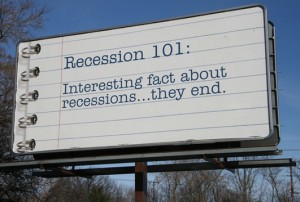The other day I got to thinking about why cap rates go up and down. The typical answer, even for those that know nothing about real estate, is to just think “supply and demand”. Today was different because the traditional answer wasn’t good enough (maybe it was something I ate:) Let’s just think about what’s current: the increase in cap rates due to the recession.
The 800 Pound Gorilla
 The reality of it is that supply and demand only takes you so far in explaining higher recessionary cap rates. The first and, in my opinion, most important change is lending practices. First the media chimes in about economic fears, then Wall Street starts to react (not the same way every day, of course), then before you know it, a mentality starts to set in. That mentality reaches the lenders faster than Batman picks up the Bat Phone. So what happens is that they make fewer loans. Fewer loans means fewer deals, so more properties stay on the market. Inventory increases and soon supply outpaces demand. It is at this point that we have more validity to just say “supply and demand”, but it’s really the changes that lead up to it that paint the picture.
The reality of it is that supply and demand only takes you so far in explaining higher recessionary cap rates. The first and, in my opinion, most important change is lending practices. First the media chimes in about economic fears, then Wall Street starts to react (not the same way every day, of course), then before you know it, a mentality starts to set in. That mentality reaches the lenders faster than Batman picks up the Bat Phone. So what happens is that they make fewer loans. Fewer loans means fewer deals, so more properties stay on the market. Inventory increases and soon supply outpaces demand. It is at this point that we have more validity to just say “supply and demand”, but it’s really the changes that lead up to it that paint the picture.
Getting Chased Out of Dodge
The second most important part of the supply and demand equation is the wholesale shift in market participants. The speculators and investors are driven out by the inability to finance new acquisitions and renovate existing projects. Even if they’re forced to stay, they don’t demand more acquisitions. So in addition to supply going up, a whole segment of demand stops doing what it does best. Nothing surprising here… supply goes up at the same time as demand goes down. What this does, however, is speed the process of switching from a hot market to a cold one. When this recession began, we saw it happen in 30 to 60 days. It’s amazing how fast it turns… and how many people get caught in between.
What then happens is a prolonged period of decline when property owners have to take the pain. Then, all of a sudden, it seems that the bottom fishing investors hop on board. It happens when they feel the market has bottomed out or is nearing bottom. We’ve seen that happen in the past two months. Now demand increases… but not in the way that you might think.
Get It While It’s… Hot?
Because supply has increased so much and there are people willing to make some great deals to stay out of foreclosure, the best deals get bought by up quickly, leaving lots of stragglers. Banks also take over properties they don’t want and are pressured to liquidate them to these investors. What’s different is that they don’t account for enough demand to swing the market back up. The investors are picking the best deals because the only way to buy is pure cash. They know two things:
- It may be a long time before they can refinance out their investment
- There’s a limit to how much they can buy. Out-of-cash means out-of-deals.
Uncapping the Cap Rate
So now we’re reaching a point that is the equivalent of where we are now. The best deals have the highest cap rates so the sales start showing higher cap rates. We’ve made the cap rate swing because the majority of cap rate data now shows higher cap rate numbers than when things were hot or before there was enough inventory of good deals for the cash investor to enter the market.
Conclusions
I’m not trying to itemize every change that happens when the economy switches over from hot to cold. Although I have a whole list of things, only two really matter. One explains supply and one explains demand – so I guess we’re right back to our pat “supply and demand” answer again.

